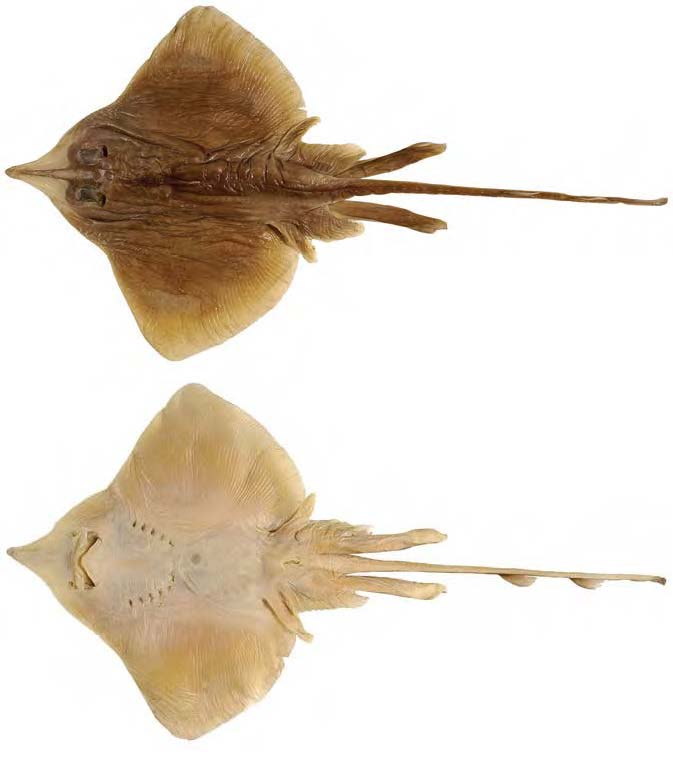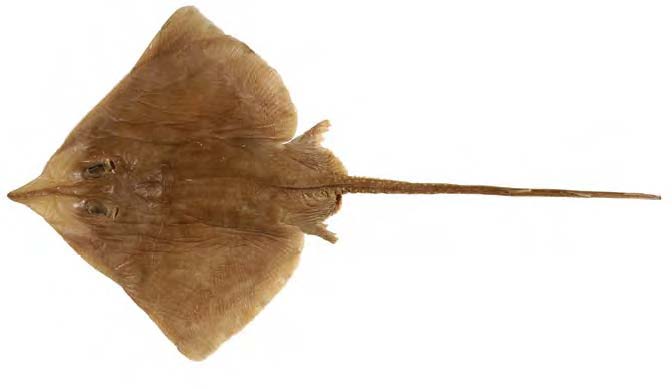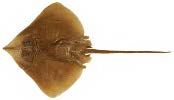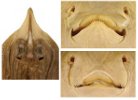Okamejei arafurensis
Last & Gledhill, 2008
Arafura skate
Classification: Elasmobranchii Rajiformes Rajidae
Reference of the original description
Two new skates of the genus Okamejei (Rajoidei: Rajidae) from the south-east Indian Ocean. CSIRO Marine and Atmospheric Research Paper, 21, 119–134
Two new skates of the genus Okamejei (Rajoidei: Rajidae) from the south-east Indian Ocean. CSIRO Marine and Atmospheric Research Paper, 21, 119–134
Image of the original description

Okamejei arafurensis sp. nov, adult male holotype (NTM S 13580–010, 407 mm TL, preserved): A, dorsal surface; B, ventral surface. In: Last, P.R. & GLEDHILL, D.C. 2008 Two new skates of the genus Okamejei (Rajoidei: Rajidae) from the south-east Indian Ocean. CSIRO Marine and Atmospheric Research Paper, 21: 119-134

Okamejei arafurensis sp. nov, adult male holotype (NTM S 13580–010, 407 mm TL, preserved): A, dorsal surface; B, ventral surface. In: Last, P.R. & GLEDHILL, D.C. 2008 Two new skates of the genus Okamejei (Rajoidei: Rajidae) from the south-east Indian Ocean. CSIRO Marine and Atmospheric Research Paper, 21: 119-134
Types
Okamejei arafurensis
Holotype: NTM: S 13580-010; Paratype: CSIRO: H 6638-01; NTM: S 13147-012; NTM: S 13580-011; NTM: S 13579-010; NTM: S 12641-027; NTM: S 12567-008;
Okamejei arafurensis
Holotype: NTM: S 13580-010; Paratype: CSIRO: H 6638-01; NTM: S 13147-012; NTM: S 13580-011; NTM: S 13579-010; NTM: S 12641-027; NTM: S 12567-008;
Description :
Citation: Okamejei arafurensis Last & Gledhill, 2008: In: Database of modern sharks, rays and chimaeras, www.shark-references.com, World Wide Web electronic publication, Version 12/2025
Please send your images of "Okamejei arafurensis" to info@shark-references.com

Dorsal surface of Okamejei arafurensis sp. nov. primary female paratype (NTM S 12567–008, 495 mm TL, preserved);In: Last, P.R. & GLEDHILL, D.C. 2008 Two new skates of the genus Okamejei (Rajoidei: Rajidae) from the south-east Indian Ocean. CSIRO Marine and Atmospheric Research Paper, 21: 119-134

Dorsal surface of Okamejei arafurensis sp. nov. primary female paratype (NTM S 12567–008, 495 mm TL, preserved);In: Last, P.R. & GLEDHILL, D.C. 2008 Two new skates of the genus Okamejei (Rajoidei: Rajidae) from the south-east Indian Ocean. CSIRO Marine and Atmospheric Research Paper, 21: 119-134
Common names
 Arafura skate
Arafura skate
 Arafura skate
Arafura skate
Short Description
Original diagnosis after LAST & GLEDHILL, 2008 [3313]: A medium-sized species of Okamejei (to at least 50 cm TL) with the following combination of characters: disc narrow with angular apices, width 54– 61% TL, 1.2–1.3 times its length; snout angle 74–96°; tail long, length 1.1–1.3 in distance from snout tip to rear of cloaca; tail slender, width 1.2–1.5 times height at its midlength, 1.1–1.5 times at first dorsal-fin origin; preupper jaw length 12–15% TL, 1.7–2.2 times internasal width; ventral head length 24–27% TL; snout length 3.5–4.0 times interorbital width; orbit diameter 72–98% interorbital width; first dorsal-fin height 2.6–3.5 in its base length; distance from first dorsal-fin origin to tail tip 3.7–4.4 times first dorsal-fin base length, 0.5–0.8 times caudal-fin length; pelvic fins of medium size, length of posterior lobe in late adolescent male 15% TL, length of anterior lobe 70–97% of posterior lobe; adult clasper 22– 24% TL, connected to pelvic-fin inner margin at about 31–37% of its length from cloaca; clasper glans bulbous, funnel not claw-like or directed posteriorly; anterior margins of both surfaces of disc of males with denticle bands, dorsal bands absent in females and juveniles; nuchal thorns absent; malar thorns patch small; tail with variably developed thorn rows, males with a single poorly developed row, large females usually with 5 rows (lateral rows usually better developed than median row); total pectoral radials 71–76; trunk centra 25–27; predorsal centra 68–73; total centra 120–132; tooth rows in upper jaw 34–38; mainly uniform greyish brown dorsally, rostral cartilage strongly demarcated from rest of snout; ventral surface pale, white or translucent; ventral sensory pores not dark edged or surrounded by greyish blotches; juveniles with blackish dorsal and caudal fins.
Original diagnosis after LAST & GLEDHILL, 2008 [3313]: A medium-sized species of Okamejei (to at least 50 cm TL) with the following combination of characters: disc narrow with angular apices, width 54– 61% TL, 1.2–1.3 times its length; snout angle 74–96°; tail long, length 1.1–1.3 in distance from snout tip to rear of cloaca; tail slender, width 1.2–1.5 times height at its midlength, 1.1–1.5 times at first dorsal-fin origin; preupper jaw length 12–15% TL, 1.7–2.2 times internasal width; ventral head length 24–27% TL; snout length 3.5–4.0 times interorbital width; orbit diameter 72–98% interorbital width; first dorsal-fin height 2.6–3.5 in its base length; distance from first dorsal-fin origin to tail tip 3.7–4.4 times first dorsal-fin base length, 0.5–0.8 times caudal-fin length; pelvic fins of medium size, length of posterior lobe in late adolescent male 15% TL, length of anterior lobe 70–97% of posterior lobe; adult clasper 22– 24% TL, connected to pelvic-fin inner margin at about 31–37% of its length from cloaca; clasper glans bulbous, funnel not claw-like or directed posteriorly; anterior margins of both surfaces of disc of males with denticle bands, dorsal bands absent in females and juveniles; nuchal thorns absent; malar thorns patch small; tail with variably developed thorn rows, males with a single poorly developed row, large females usually with 5 rows (lateral rows usually better developed than median row); total pectoral radials 71–76; trunk centra 25–27; predorsal centra 68–73; total centra 120–132; tooth rows in upper jaw 34–38; mainly uniform greyish brown dorsally, rostral cartilage strongly demarcated from rest of snout; ventral surface pale, white or translucent; ventral sensory pores not dark edged or surrounded by greyish blotches; juveniles with blackish dorsal and caudal fins.
Remarks
shark-references Species-ID=4304;
shark-references Species-ID=4304;


















